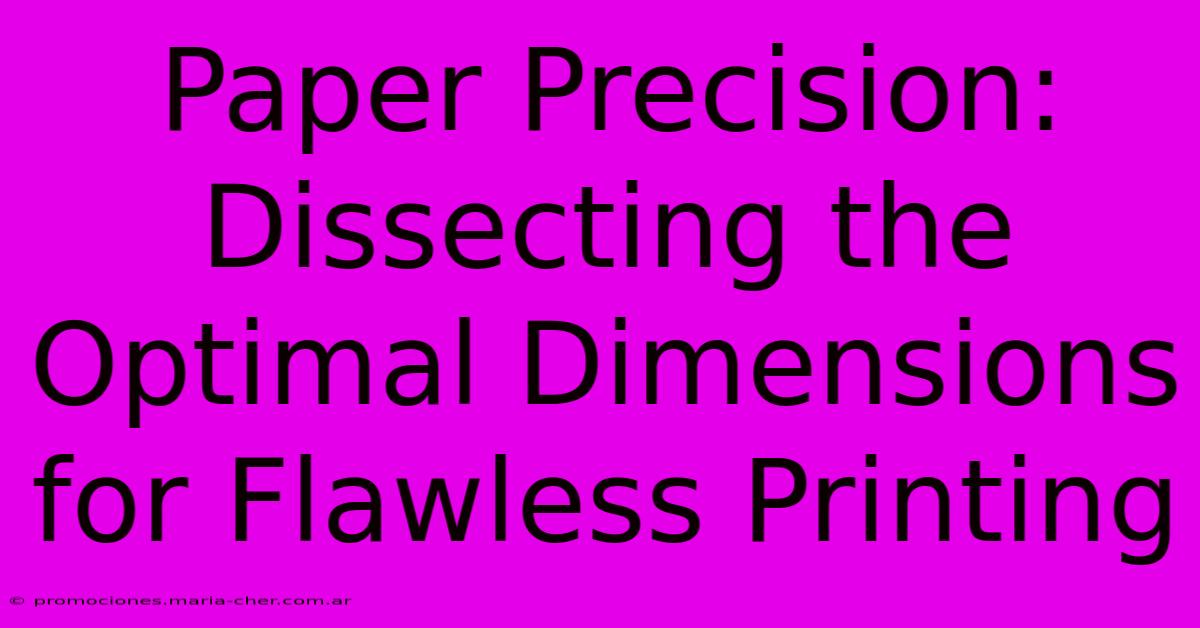Paper Precision: Dissecting The Optimal Dimensions For Flawless Printing

Table of Contents
Paper Precision: Dissecting the Optimal Dimensions for Flawless Printing
Choosing the right paper size is often overlooked in the printing process, yet it significantly impacts the final output's quality and professionalism. From crisp business cards to stunning photographic prints, understanding optimal paper dimensions is crucial for flawless results. This guide dissects the key considerations for selecting the perfect paper size for your printing needs.
Understanding Paper Size Standards
Before diving into optimal dimensions, let's establish a foundation in common paper size standards. These standards ensure compatibility with various printers and printing services. The most prevalent standards include:
- US Letter (8.5 x 11 inches): The ubiquitous standard in North America for general-purpose printing, documents, and letters.
- A4 (210 x 297 mm or 8.27 x 11.69 inches): The international standard, widely used in Europe, Asia, and other regions. Slightly taller and narrower than US Letter.
- Legal (8.5 x 14 inches): Larger than Letter, often used for legal documents, longer letters, and certain types of marketing materials.
- Executive (7.25 x 10.5 inches): Smaller than Letter, offering a more compact format suitable for smaller documents or invitations.
Beyond the Basics: Specialized Sizes
Beyond the standard sizes, specialized paper dimensions cater to specific applications:
- Business Cards: Typically 3.5 x 2 inches, though variations exist. Precise dimensions ensure perfect alignment and a professional look.
- Photo Prints: Common sizes include 4x6, 5x7, 8x10, and various others, dictated by standard photo formats and framing options.
- Envelopes: Sizes correspond to the paper they enclose, with variations depending on the type of mail and intended use.
Choosing the Optimal Dimensions for Your Project
Selecting the right paper size depends heavily on the project's purpose and intended use. Here’s a breakdown:
1. Defining Your Project's Purpose:
- Business Documents: US Letter or A4 are the most common choices for reports, letters, and presentations. Legal size is appropriate for longer documents.
- Marketing Materials: Consider the intended audience and the design's impact. Brochures might require custom sizes for optimal visual appeal, while flyers often utilize standard sizes for ease of distribution.
- Photography: Standard photo print sizes are readily available, while custom sizes might be necessary for unique artistic projects or large-format prints.
- Invitations: The size of the invitation should complement the overall design and theme, often choosing smaller, more elegant formats.
2. Content and Layout Considerations:
- Text-heavy documents: Ensure sufficient space for readability. Avoid cramming too much text onto a small page.
- Image-heavy documents: Choose a size that showcases images effectively without compromising quality. Large formats allow for greater detail.
- Multi-panel layouts: Consider the folds and how they'll affect the final size of the printed piece.
3. Printer Compatibility:
- Check your printer's specifications: Ensure your printer supports the chosen paper size to avoid jams or misalignment.
- Consider paper tray limitations: Some printers have limited capacity for larger or custom-sized paper.
Maximizing Print Quality with Proper Paper Selection
Paper type also plays a crucial role. The correct paper stock (weight and texture) complements the chosen dimensions:
- Thicker paper (higher gsm): Provides a more substantial feel, perfect for business cards, invitations, and high-quality brochures.
- Thinner paper (lower gsm): Suitable for large-volume printing like flyers or general documents where cost-effectiveness is prioritized.
- Matte paper: Reduces glare and offers a classic, professional look.
- Glossy paper: Enhances vibrancy and is ideal for photos and marketing materials that need to stand out.
Conclusion: Precision for Perfection
Achieving flawless prints requires meticulous attention to detail, with paper size and type being key components. By carefully considering the project's purpose, content layout, printer compatibility, and desired aesthetic, you'll ensure your printed materials make a lasting impression. Remember, the precision of your paper choices directly reflects the professionalism and quality of your final product.

Thank you for visiting our website wich cover about Paper Precision: Dissecting The Optimal Dimensions For Flawless Printing. We hope the information provided has been useful to you. Feel free to contact us if you have any questions or need further assistance. See you next time and dont miss to bookmark.
Featured Posts
-
Discover The Hoop That Flatters Every Face The Monica Vinader Style Guide
Feb 11, 2025
-
Unparalleled Elegance Awaits Unveiling Cambridge Crossing By Perry Homes
Feb 11, 2025
-
Your Quest For Jewelry Bliss Monica Vinader Sale Dates Revealed
Feb 11, 2025
-
Discover The Secret To Luxury Living In Castroville Perry Homes Enchanted Estates
Feb 11, 2025
-
The Ultimate Home Destination Perry Homes Castroville Masterpieces Revealed
Feb 11, 2025
